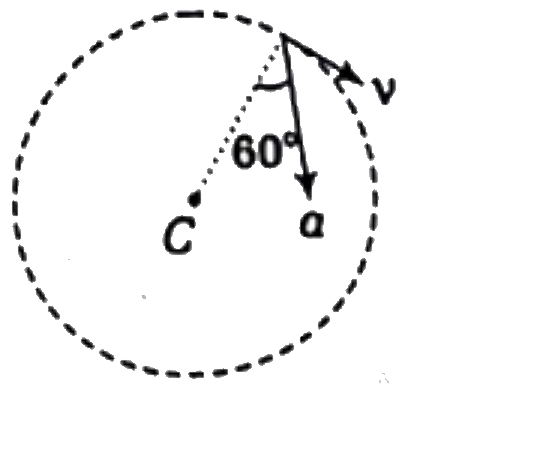A particle with the constant speed in a circle of radius r and time period T.The centripetal acceleration of a particle is
‘r2‘T
‘T2‘r
(2πT)2r
(2πT)2r
The correct Answer is:C
To find the centripetal acceleration of a particle moving in a circle with a constant speed, we can follow these steps:
1. Understanding Centripetal Acceleration:
Centripetal acceleration (ac) is the acceleration that keeps a particle moving in a circular path and is directed towards the center of the circle. The formula for centripetal acceleration is given by:
ac=v2r
where v is the linear speed of the particle and r is the radius of the circular path.
2. Relating Linear Speed to Angular Velocity:
The linear speed v can also be expressed in terms of angular velocity (ω) as:
v=rω
where ω is the angular velocity in radians per second.
3. Substituting for Linear Speed:
Substituting v=rω into the centripetal acceleration formula gives:
ac=(rω)2r=r2ω2r=rω2
4. Relating Angular Velocity to Time Period:
The angular velocity ω is related to the time period T (the time taken for one complete revolution) by the formula:
ω=2πT
5. Substituting Angular Velocity into Centripetal Acceleration:
Now, substituting ω=2πT into the centripetal acceleration formula:
ac=r(2πT)2
6. Simplifying the Expression:
Simplifying the expression gives:
ac=r⋅4π2T2=4π2rT2
Final Result:
Thus, the centripetal acceleration of the particle is:
ac=4π2rT2
Centripetal acceleration (ac) is the acceleration that keeps a particle moving in a circular path and is directed towards the center of the circle. The formula for centripetal acceleration is given by:
ac=v2r
where v is the linear speed of the particle and r is the radius of the circular path.
The linear speed v can also be expressed in terms of angular velocity (ω) as:
v=rω
where ω is the angular velocity in radians per second.
Substituting v=rω into the centripetal acceleration formula gives:
ac=(rω)2r=r2ω2r=rω2
The angular velocity ω is related to the time period T (the time taken for one complete revolution) by the formula:
ω=2πT
Now, substituting ω=2πT into the centripetal acceleration formula:
ac=r(2πT)2
Simplifying the expression gives:
ac=r⋅4π2T2=4π2rT2
Thus, the centripetal acceleration of the particle is:
ac=4π2rT2
Topper's Solved these Questions
Similar Questions
A particle moves in a circle of radius 5 cm with constant speed and time period 0.2πs. The acceleration of the particle is
View SolutionA particle moves with constant speed v along a circular path of radius r and completes the circle in time T. The acceleration of the particle is
View SolutionA particle of mass m describes a circle of radius r . The centripetal acceleration of the particle is 4r2 . What will be the momentum of the particle ?
View SolutionThe figure shows the total acceleration a=32ms−2 of a moving particle moving clockwise in a circle of radius R = 1 m . What are the centripetal acceleration a and speed of the particle at the given instant ?

View SolutionA particle of mass M is moving in a circle of fixed radius R in such a way that its centripetal acceleration at time t is given by n2Rt2 where n is a constant. The power delivered to the particle by the force acting on it, it :
View SolutionIf a particle moves in a circle of radius of 4m at speed given by v=2t where v is in m/s and t in sec.At t=4s ,net accleration of particle will be:
View SolutionA particle of mass m moves along a horizontal circle of radius R such that normal acceleration of particle varies with time as an=kt2. where k is a constant.
Total force on particle at time t s is
View SolutionA particle of mass m moves along a horizontal circle of radius R such that normal acceleration of particle varies with time as an=kt2. where k is a constant.
Tangential force on particle at t s is
View SolutionA particle moves on a circle of radius r with centripetal acceleration as function of time as ac=k2rt2, where k is a positive constant. Find the following quantities as function of time at an instant :
(a) The speed of the particle
(b) The tangential acceleration of the particle
( c) The resultant acceleration, and
(d) Angle made by the resultant acceleration with tangential acceleration direction.
View SolutionA particle of mass m moves along a horizontal circle of radius R such that normal acceleration of particle varies with time as an=kt2. where k is a constant.
Power developed by total at time T is
View Solution
